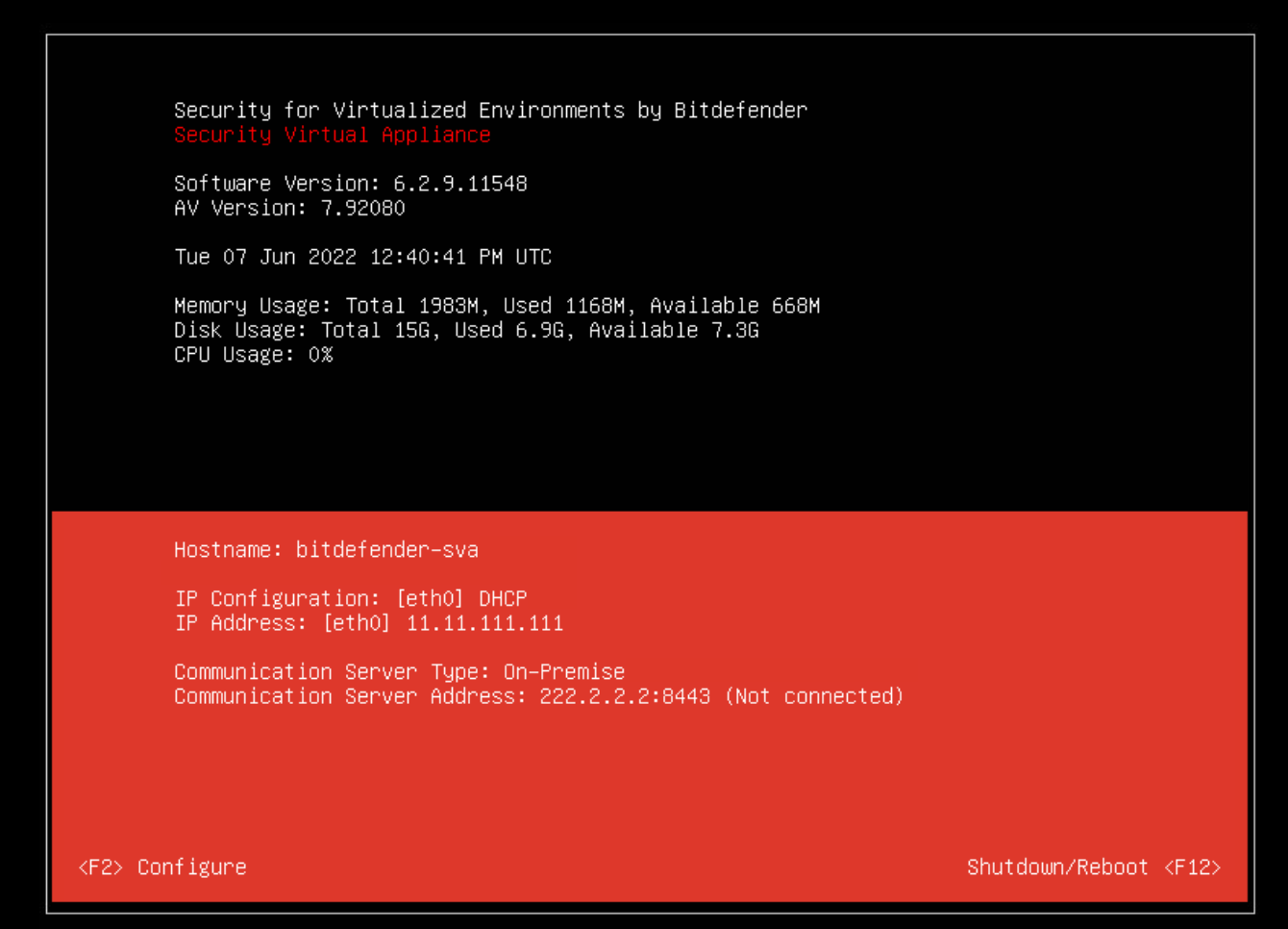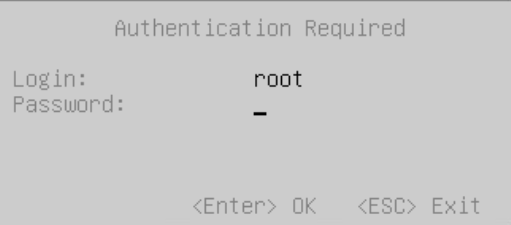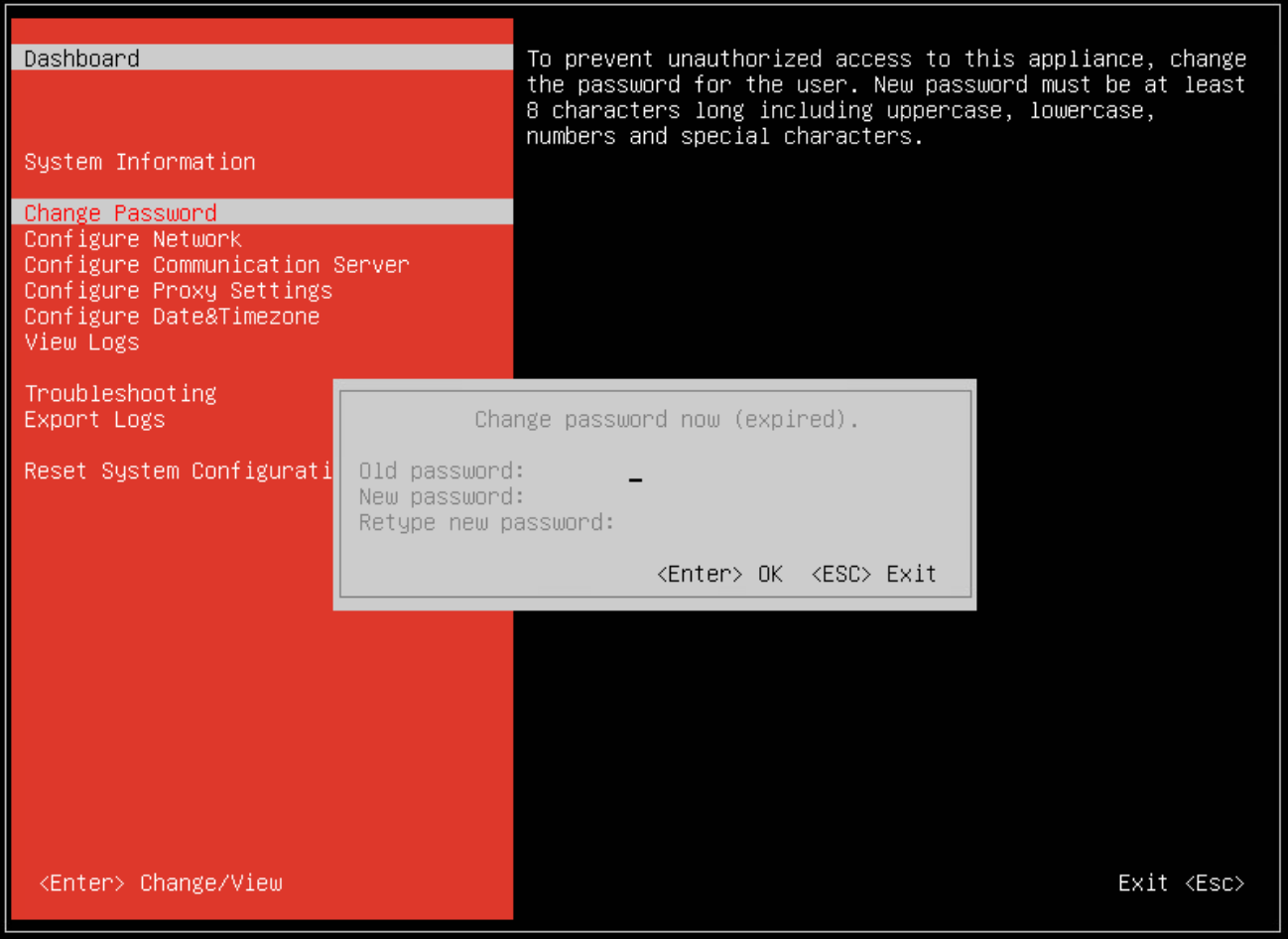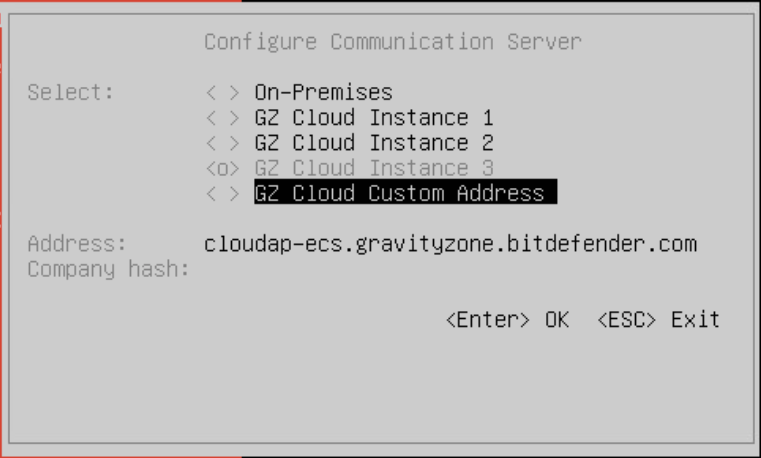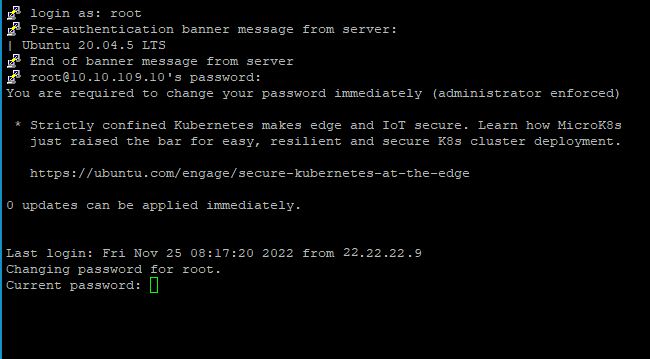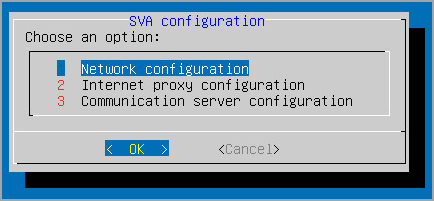Install Security Server manually
This section provides you with information regarding the Security Server manual installation on various platforms.
Install the Security Server in Nutanix Prism
This section describes how to manually deploy Bitdefender Security Server in Nutanix Prism.
GravityZone allows you to integrate Control Center with Nutanix Prism Element for high-class protection of your virtualization platform. You are able to integrate one or more Nutanix Prism Element clusters, either registered or unregistered to Nutanix Prism Central.
Nutanix Prism Element integration overview
To protect a Nutanix Prism Element cluster, you have to deploy a Bitdefender Security Server on each host. You can do this by running a remote installation task in the GravityZone Control Center. However, the installation task may fail when the Nutanix Prism Element cluster is registered to Prism Central or because of other reasons.
When Nutanix Prism Element is registered to Prism Central, GravityZone is unable to automatically upload the Security Server in Nutanix because of certain user restrictions. Therefore, you need to:
Upload the Security Server image in Nutanix Prism Central.
Run the installation task again in the GravityZone Control Center.
When Nutanix Prism Element is not registered to Prism Central, but the remote installation task still fails, you need to:
Run again the installation task in GravityZone Control Center.
If the case, upload and configure Security Server in Nutanix Prism Element.
Important
The Nutanix Prism Element integration with GravityZone requires a Nutanix user with Cluster Admin or User Admin privileges. Please review these privileges when performing tasks in Control Center.
How to upload the Security Server image in Nutanix Prism
Requirements
Before starting Security Server upload and configuration in Nutanix Prism, you must have at hand:
Nutanix Prism credentials.
A Bitdefender Security Server image in VMDK format. You can download it from Network > Installation Packages in the GravityZone Control Center.
Uploading the Security Server in Nutanix Prism Central
You need to manually upload the Security Server image in Nutanix Prism Central when the Nutanix Prism Element cluster is registered to Prism Central. Follow these steps:
Important
Wait for the image to be both uploaded and updated. After that, run the installation task again in GravityZone Control Center.
Log in to Nutanix Prism Central.
Go to Explore > Images.
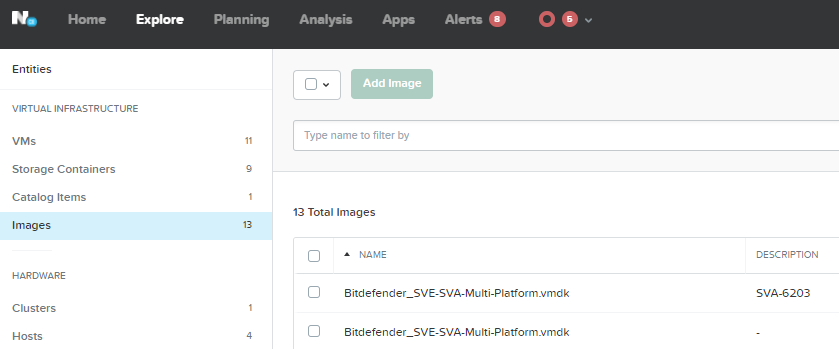
Click Add Image.
Make sure you have the Image File radio button selected and click Add File to select the Bitdefender image from where it is stored.
Check the image details:
Under Image Name, keep the file original name:
Bitdefender_SVE-SVA-Multi-Platform.vmdk. Otherwise, the Security Server installation will fail.Under Image Type, select Disk.
Optionally, add an image description.
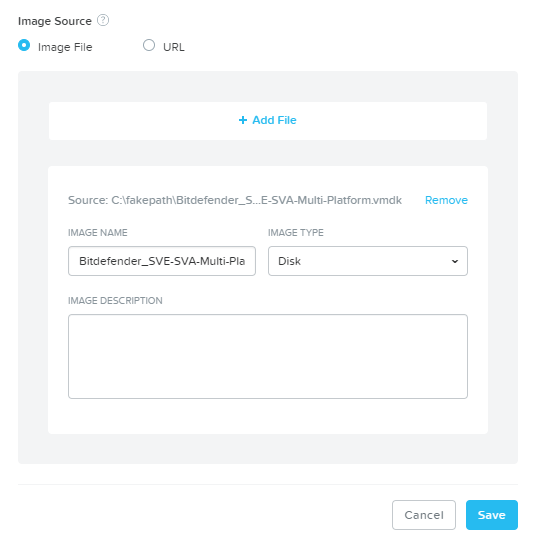
Click Save. The Security Server image upload begins and it can take several minutes. You can view the progress in Tasks.
Uploading Security Server in Nutanix Prism Element
This is how you manually upload the Security Server when Nutanix Prism Element in not registered to Prism Central:
Log in to Nutanix Prism Element.
Go to Settings > Image Configuration.
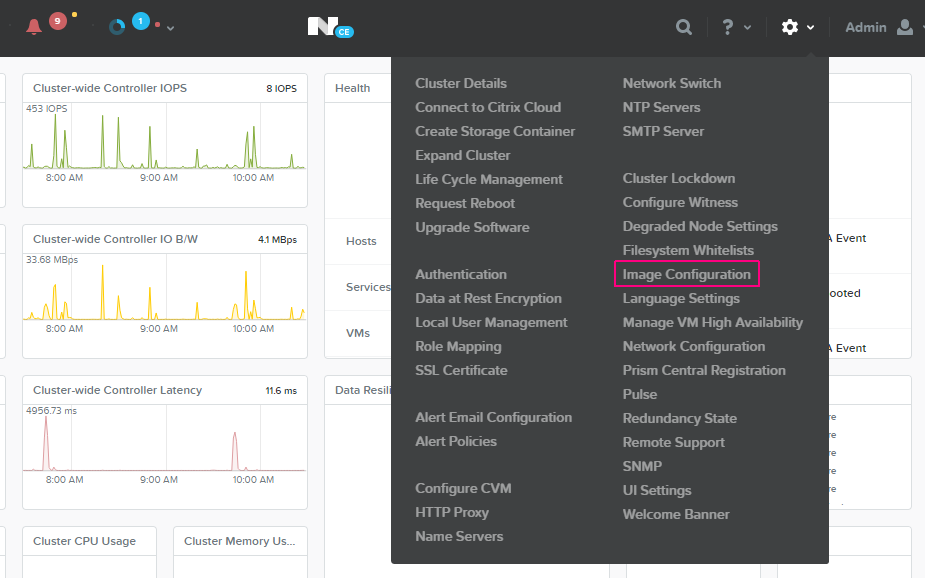
Click Upload Image. A new window appears.
Fill in the details:
Name.
Annotation.
Select the image type: DISK.
Select the preferred storage container.
Click Upload a file, then click Choose File to select the Security Server image from where it is stored.
Click Save.
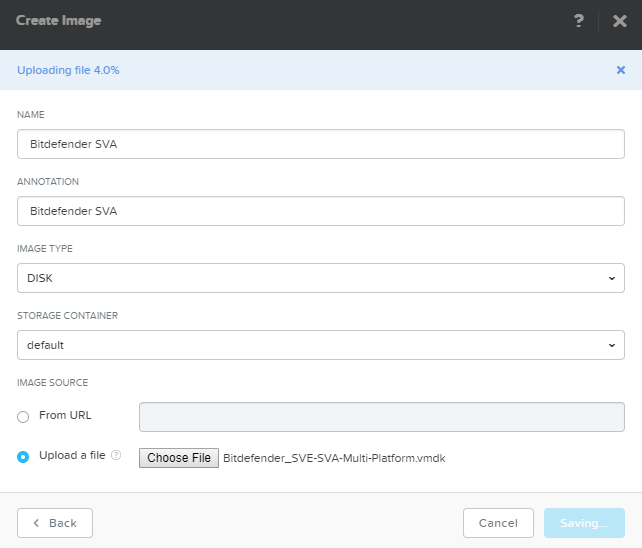
The Security Server image upload begins and it can take several minutes. You can view the progress in Tasks.
Wait for the image to be both uploaded and updated.
How to configure Security Server in Nutanix Prism
Once you have the Security Server image uploaded in Nutanix Prism, you can either:
Run a remote installation task in GravityZone Control Center. The Security Server is automatically configured.
Manually configure Security Server in Nutanix Prism. That means you have to create a Security Server virtual machine, power it on and configure the communication server appliance address in the Security Server console.
To configure a Security Server virtual machine you must follow these steps in Prism Element or in Prism Central:
Go to the virtual machines list and click Create VM.
Fill in the required details:
Under General Configuration, enter a name and, optionally, a description.
Under Compute Details, choose 2 VCPUs, 1 core per VCPU and 3 GB of memory.
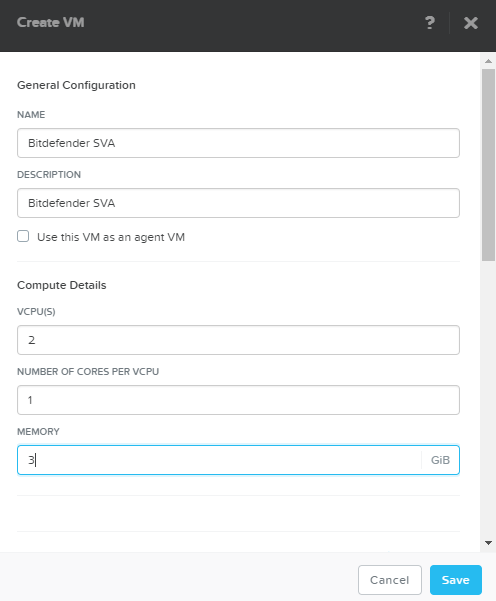
Under Disks, remove the default CD-ROM disk, confirm the action and click Add New Disk. Configure the disk as follows:
Type: Disk.
Operation: Clone from Image Service.
Bus Type: SCSI.
Image: Select the Security Server image you have uploaded.
Click Add.
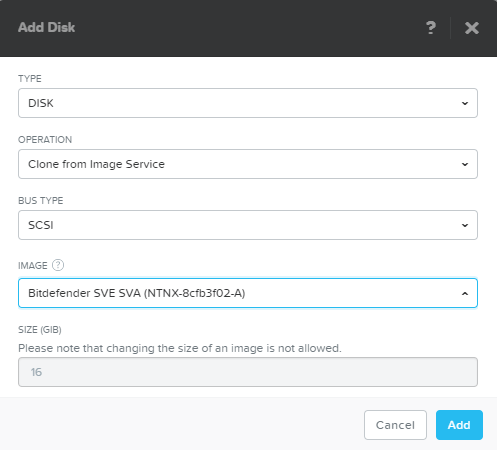
Under Network Adapters (NIC):
Click Add New NIC.
Choose the preferred network.
Click Add.
Under VM Host Affinity:
Click Set Affinity.
Select one of the hosts.
Click Save.
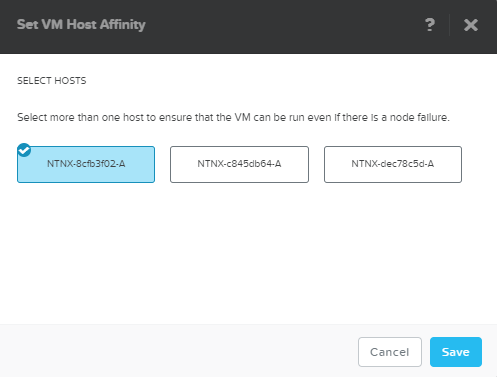
Click Save. The virtual machine is created with the VM create with customize label.
Go to virtual machines list.
Select the Security Server virtual machine.
Click Power on.
Set up the Security Server:
Install Security Server on an Ubuntu machine from XenServer, ESXi or AWS
Bitdefender provides the Security Server under several formats, such as OVA, VHD or XVA. When the virtual environment uses an unsupported format, such as Amazon Machine Image (AMI), you must manually install the Security Server.
In this section, you will learn how to install Security Server through a script on an Ubuntu machine from your environment (Citrix XenServer, VMware ESXi, AWS).
Requirements
Hardware
Memory and CPU resource allocation for the Security Server depends on the number and type of VMs running on the host. The following table lists the recommended resources to be allocated:
Consolidation | Number of protected virtual machines | RAM | CPUs |
Low | 1-30 VMs | 2 GB | 2 CPUs |
31-50 VMs | 4 GB | 2 CPUs | |
Medium | 51-100 VMs | 4 GB | 4 CPUs |
High | 101-200 VMs | 4 GB | 6 CPUs |
HDD: 16 GB (SSD, if available)
Software
Ubuntu Server 24.04 LTS must be used as the virtual machine instance.
Prerequisites
On the physical server, install Ubuntu Server 24.04, with a working internet connection.
Use any authentication method to log in.
Installation steps
Deploy a new Ubuntu 24.04 instance in your environment.
For some virtualized environments (such as AWS), the
ubuntuuser is predefined, and is by default allowed to login over SSH.For other users, aside from
rootandubuntu, the SSH login is going to be restricted. Also, the VM can have multiple users with passwords (the root user using a password) given as a parameter to the install script.Note
After installing the Security Server, a password policy is set for the
rootuser and it expires every 90 days.Change the root password:
sudo passwd rootGet root privileges:
sudo suor
sudo -iUpdate the OS to the latest version:
apt-get updateapt-get dist-upgradeDownload the script from here and unpack the archive.
Use the following command to assign an execute permission:
chmod 500 install-scan-server.datStart the installation by running the following command:
sudo ./install-scan-server.dat [--users <user_name1 user_name2 ...>].The script can be run with or without the
--users <user_name1 user_name2 ...>parameter. Therootuser password must always be set up.If the script is run and the user doesn't have a password set, the following error message is going to be displayed: "Error: provide a list of users to receive SSH access or set a usable root password. For more information, run the following command: ./install-scan-server.dat --help".
Run the same command from step 7 again to complete the installation.
Open the following log file after the installation is completed:
/opt/BitDefender/var/log/update.logCheck the output for a completed update process.
The end of the output returns the following:
dateStamp BDLIVED[4755] INFO: Done installing updates: 5 location(s) updated.Note
If the update process is not yet finished, please wait while the Security Server runs through all the updates.
Run the Security Server setup:
/opt/BitDefender/bin/sva_setup.shSelect option 3 Communication Server configuration from the menu.
Select the communication server appliance location based on your browser's URL:
For
cloudgz.gravityzone.bitdefender.com: GZ Cloud Instance 1For
cloud.gravityzone.bitdefender.com: GZ Cloud Instance 2For
cloudap.gravityzone.bitdefender.com: GZ Cloud Instance 3
Note
If you use a relay address, you must add a GZ Cloud Custom Address using the following URL format:
http://<relay-address>:7074Also, select the 4 Configure the company hash option and enter your company hash from GravityZone.
Select Ok to confirm your action.
Note
The SSH connection is allowed for root and ubuntu (if it exists on the VM) users and all the users that were added with the --users <user_name1 user_name2 ...> parameter . You can check the SSH connection for any user added as a parameter.
For any other question regarding the GravityZone product, refer to our Technical Support contact page.
Install the Security Server on Proxmox Virtual Environment
Proxmox VE supports several types of image formats, the most popular ones being: ovf and qcow2. To install the Security Server on Proxmox, follow these steps:
Download the Proxmox
qcow2image from here.Alternatively, you can go to Network > Installation packages to download the Security Server Virtual Appliance package and unzip it to access the
ovfandvmdkfiles.Import the images following the steps from the Proxmox official documentation.
Enable the QUEMU guest agent in the Proxmox VE cluster, where the Security Server was deployed:
Go to Select Virtual Machine.
Select Shut down the VM.
Select Options > QEMU Guest Agent.
Enable the agent.
Power on the VM.
Configure Security Server to connect to GravityZone:
Run the Security Server setup:
# /usr/bin/sva-setupSelect option 3 Communication Server configuration from the menu.
Select one of the following options for the communication server appliance, based on your browser's URL:
For
cloudgz.gravityzone.bitdefender.com: GZ Cloud Instance 1For
cloud.gravityzone.bitdefender.com: GZ Cloud Instance 2For
cloudap.gravityzone.bitdefender.com: GZ Cloud Instance 3
Note
If you use a relay address, you must add a GZ Cloud Custom Address using the following URL format:
http://<relay-address>:7074Select the 4 Configure the company hash option and enter your company hash from GravityZone.
Install the Security Server in Nutanix AHV
This section aims to explain how to import and deploy Bitdefender Security Server in Nutanix AHV.
Importing the Security Server
Log in to GravityZone.
Go to the Network > Packages page.
Select the default Security Server Virtual Appliance package.
Click the Download button in the upper-left side of the table and select the Nutanix Prism (VMDK) version. Depending on your browser settings, the file may be downloaded automatically to a default download location.
Log in to PRISM, the Nutanix Web Console.
Import the VMDK file:
Click the gear button in the upper-right corner of the console to access the Settings menu and select Image Configuration.
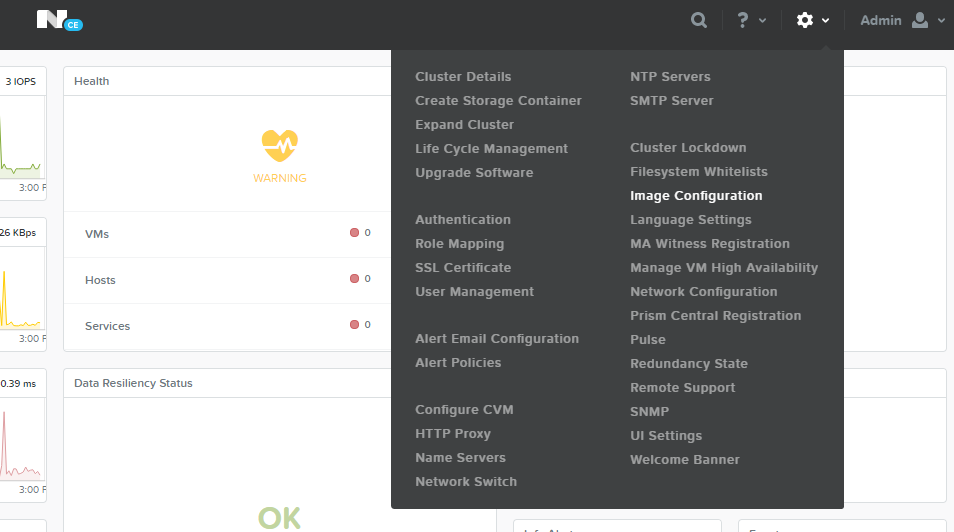
The configuration window is displayed.
Click Upload Image. A new window pops up, asking you to enter image details.
Enter a suggestive name for the image.
From the Image Type menu, choose Disk.
From Image Source, select Upload File and choose the VMDK file you have previously downloaded.
Click Save. Wait while the virtual drive is being uploaded. When completed, you will be able to view the image in the list of existing images.
Create the virtual machine for the Bitdefender Security Server VMDK file:
Go to the VM page using the menu at the upper left corner of the console.
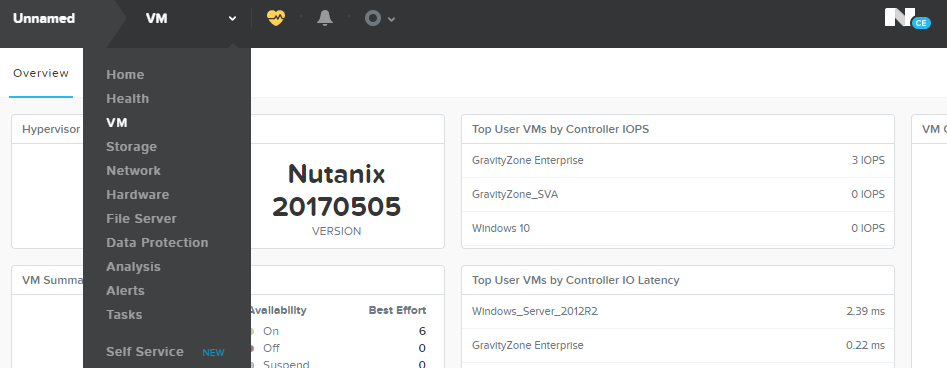
Click the Create VM button at the upper right corner of the page.

In the new configuration window, enter the requested details:
A suggestive name and a description for the VM.
Hardware configuration such as number of CPUs, cores per CPU and memory. These values must meet the Bitdefender Security Server requirements.
Click Add new disk. A configuration window is displayed.
Configure the disk settings as follows:
• Type: Disk
• Operation: Clone from Image Service
• Bus Type: SCSI
• Image: the image you have previously created.
Click Add.
Click Add new NIC and choose the network you want to use.
Click Save.
Deploying the Security Server
In Nutanix console, go to the VM > Table section.

Power on the newly created machine.
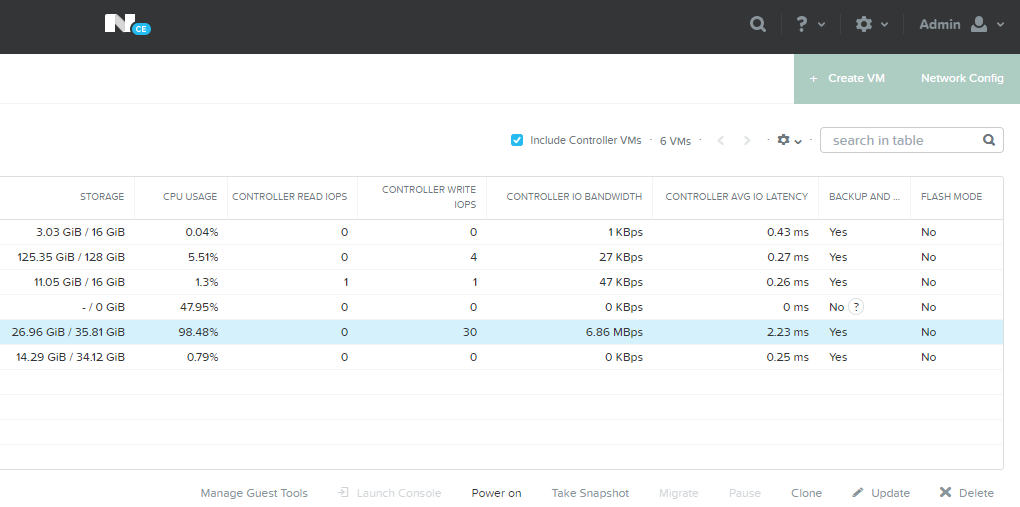
Click Launch Console.
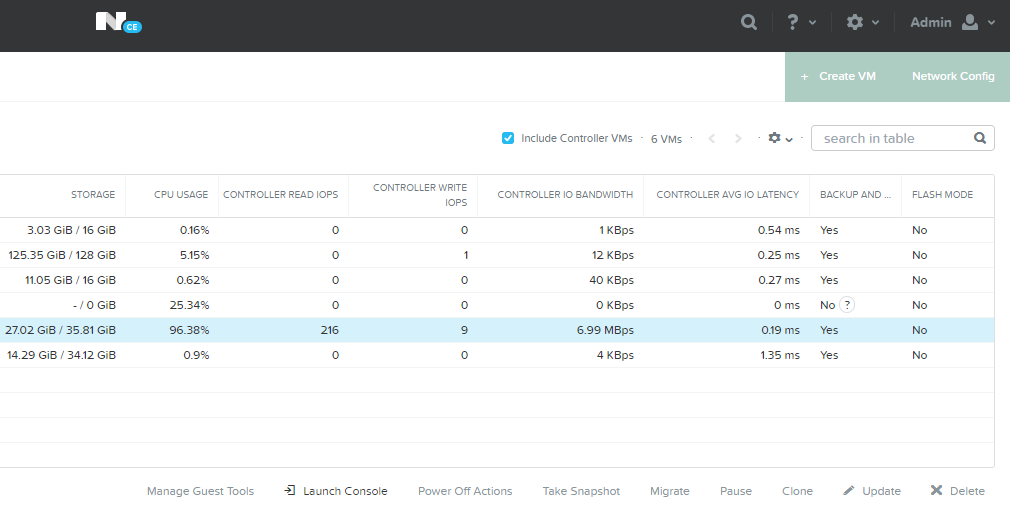
Connect to the Security Server via SSH. For details regarding configuration steps, refer to Install Security Server Multi-Platform.
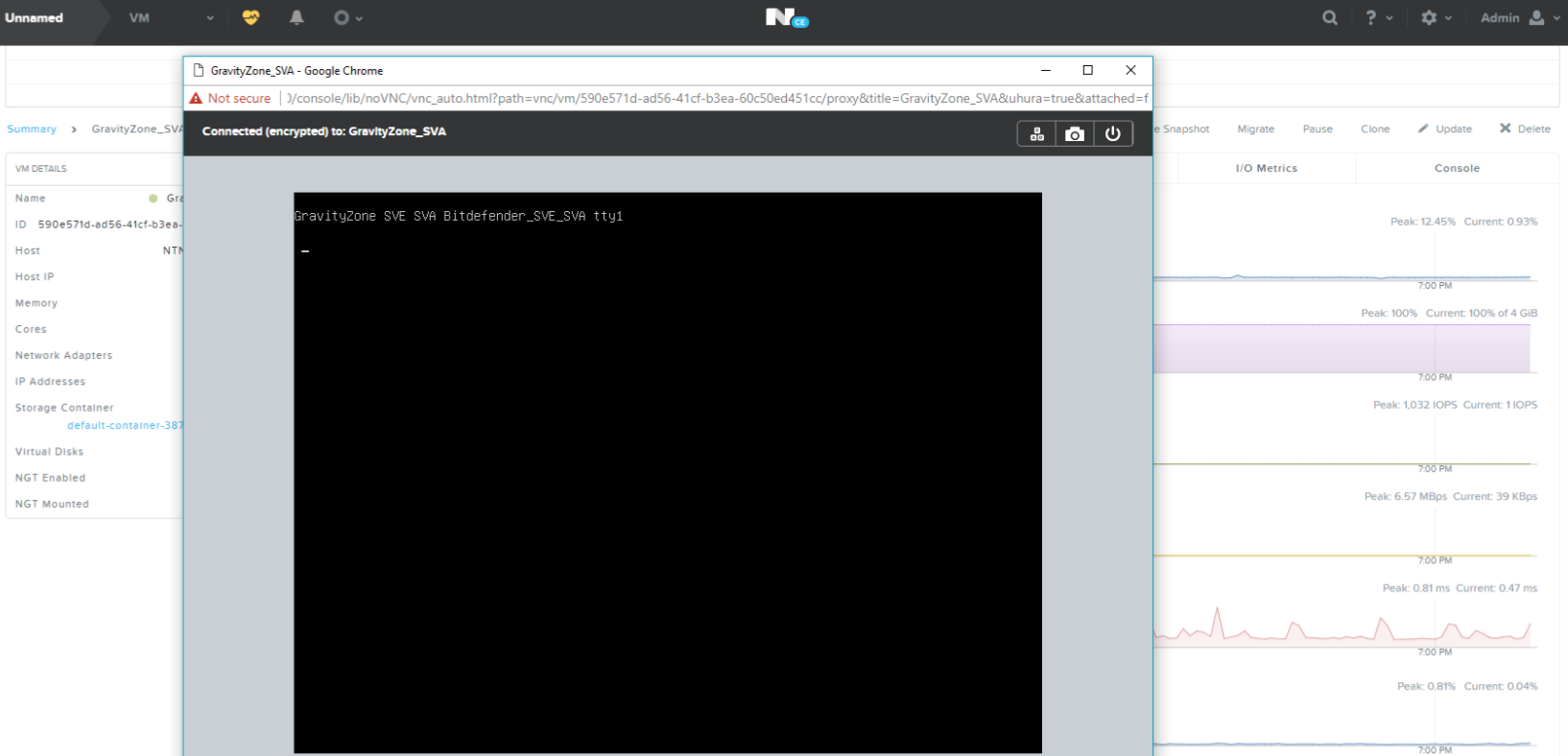
Connect to GravityZone
To connect the Security Server to GravityZone, you must follow these steps:
Run the Security Server setup:
/opt/BitDefender/bin/sva_setup.shSelect option 3 Communication Server configuration from the menu.
Select one of the following options, based on your browser's URL:
For
cloudgz.gravityzone.bitdefender.com: GZ Cloud Instance 1For
cloud.gravityzone.bitdefender.com: GZ Cloud Instance 2For
cloudap.gravityzone.bitdefender.com: GZ Cloud Instance 3
Note
To connect to GravityZone through a relay, you must add a GZ Cloud Custom Address using the following URL format:
http:/<relay-address>:7074Also, select the 4 Configure the company hash option and enter your company hash from GravityZone.
Select Ok to confirm your action.
Install Security Server in Microsoft Azure
This section describes how to use a Security Server to protect your Microsoft Azure virtual machines.
The default scan mode for Microsoft Azure virtual machines is Local Scan (security content is stored on the installed security agent, and the scan is run locally on the machine). If you want to scan your Microsoft Azure virtual machines with a Security Server, you need to configure the security agent’s installation package and the applied policy accordingly.
Note
Make sure you have the minimum hardware requirements. For more information, refer to Requirements.
Installation steps
Create the virtual machine in Azure.
The VM can have multiple users with passwords (the root user using a password) given as a parameter to the install script.
Note
Ubuntu Server 24.04 LTS must be used as the virtual machine instance.
After installing the Security Server, a password policy is set for the
rootuser and it expires every 90 days.Change the root password:
sudo passwd rootGet root privileges:
sudo suor
sudo -iUpdate the OS to the latest version:
apt-get updateapt-get dist-upgradeDownload the script from here and unpack the archive.
Use the following command to assign an execute permission:
chmod 500 install-scan-server.datStart the installation by running the following command:
sudo ./install-scan-server.dat [--users <user_name1 user_name2 ...>].The script can be run with or without the
--users <user_name1 user_name2 ...>parameter. Therootuser password must always be set up.If the script is run and the user doesn't have a password set, the following error message is going to be displayed: "Error: provide a list of users to receive SSH access or set a usable root password. For more information, run the following command: ./install-scan-server.dat --help".
Run the same command from step 7 again to complete the installation.
Open the following log file after the installation is completed:
/opt/BitDefender/var/log/update.logCheck the output for a completed update process.
The end of the output returns the following:
dateStamp BDLIVED[4755] INFO: Done installing updates: 5 location(s) updated.Note
If the update process is not yet finished, please wait while the Security Server runs through all the updates.
Configure Security Server to connect to GravityZone:
Run the Security Server setup:
# /usr/bin/sva-setupSelect option 3 Communication Server configuration from the menu.
Select one of the following options for the communication server appliance, based on your browser's URL:
For
cloudgz.gravityzone.bitdefender.com: GZ Cloud Instance 1For
cloud.gravityzone.bitdefender.com: GZ Cloud Instance 2For
cloudap.gravityzone.bitdefender.com: GZ Cloud Instance 3
Note
If you use a relay address, you must add a GZ Cloud Custom Address using the following URL format:
http://<relay-address>:7074Configure the Company hash - the GravityZone company hash where the Network sensor sends the data (Login to GravityZone > My Company > My Company hash).
Select Ok to confirm your action.
Note
After installing the Security Server manually, you can only login with the root user over SSH.
Install the Security Server in Microsoft Hyper-V
You can install Security Server in Microsoft Hyper-V as follows:
Access Hyper-V Manager.
Select the Hyper-V host.
Download the
.vhdor.vhdximages from GravityZone Control Center > Packages.Select your Hyper-V Server from the Hyper-V Manager.
Right click your Hyper-V Server.
Select New > Virtual Machine...
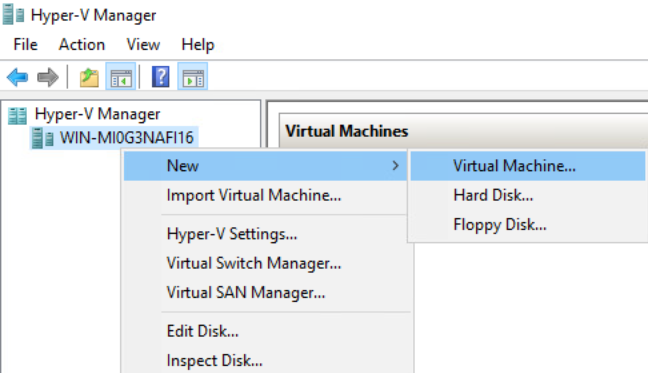
In the Specify Name and Location window, add your virtual machine name and the location where the image was downloaded.
In the Specify Generation window you must:
Select Generation 1 if you have dowloaded the
.vhdimage type.Select Generation 2 if you have downloaded the
.vhdximage type.
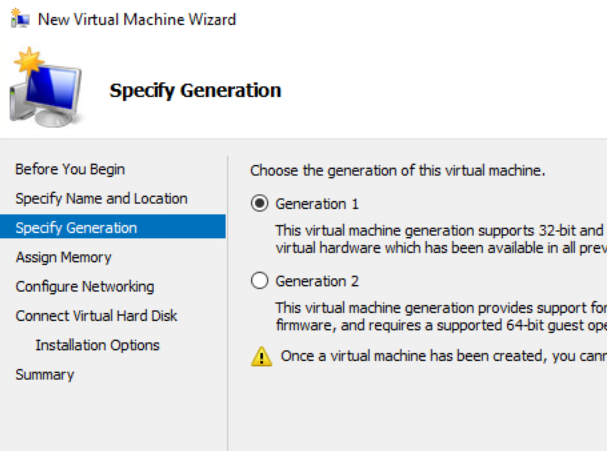
In the Assign Memory window, set the Startup Memory to 2048 MB.
In the Configure Networking window, set the Network Connection to the desired network interface.
In the Connect Virtual Hard Disk window, select Use an existing virtual hard disk and the image you have downloaded.
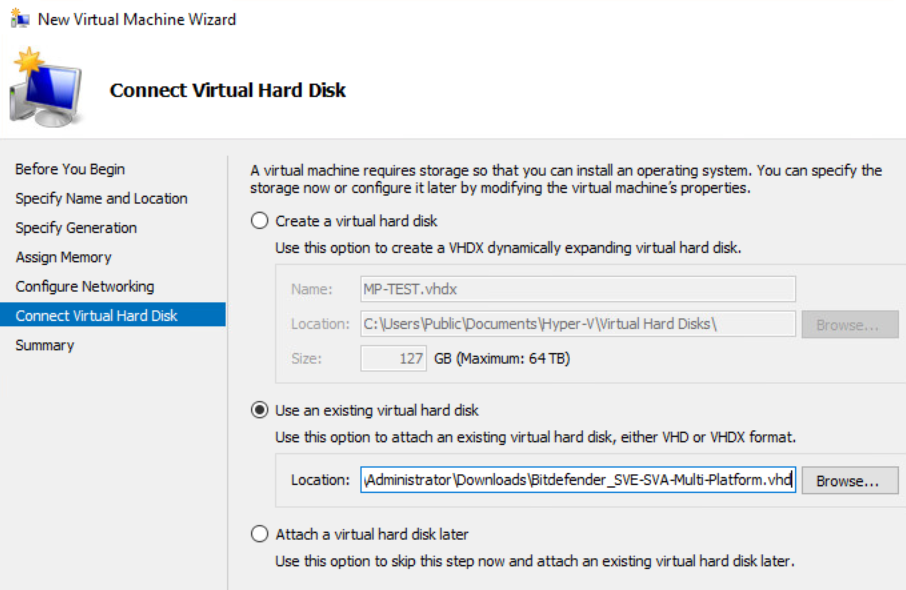
Complete the deployment wizard.
(Only for
.vhdximages) Go to Virtual Machines > Settings… > Security and right click your virtual machine.(Only for
.vhdximages) Set the template to Microsoft UEFI Certificate Authority or uncheck Enable secure boot.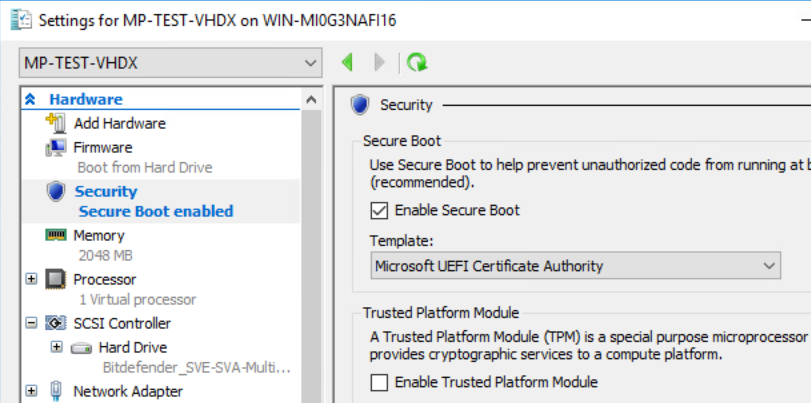
Start your virtual machine.
Configure Security Server to connect to GravityZone:
Run the Security Server setup:
# /usr/bin/sva-setupSelect option 3 Communication Server configuration from the menu.
Select one of the following options for the communication server appliance, based on your browser's URL:
For
cloudgz.gravityzone.bitdefender.com: GZ Cloud Instance 1For
cloud.gravityzone.bitdefender.com: GZ Cloud Instance 2For
cloudap.gravityzone.bitdefender.com: GZ Cloud Instance 3
Note
If you use a relay address, you must add a GZ Cloud Custom Address using the following URL format:
http://<relay-address>:7074Configure the Company hash - the GravityZone company hash where the Network sensor sends the data (Login to GravityZone > My Company > My Company hash).
Select Ok to confirm your action.
